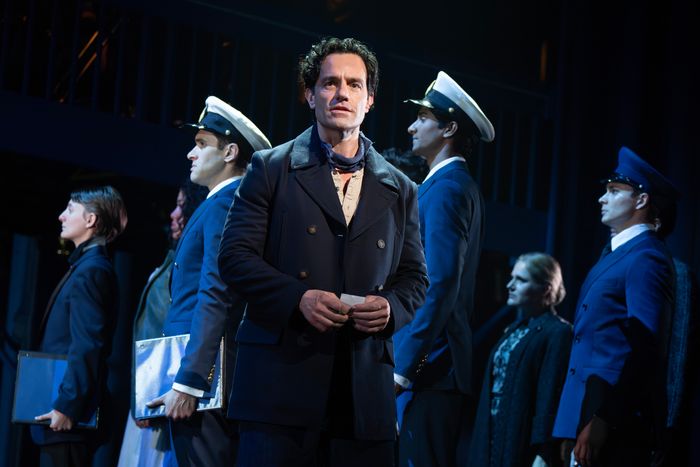
What happens when you stage a spectacle without the spectacle? Encores! has revived Peter Stone and Maury Yeston’s musical Titanic, a grand late-1990s epic that earned most of its initial notoriety from its immense budget ($10 million, big at the time) and Stewart Laing’s not always functional set. Hydraulics, when they worked, tilted the stage to simulate sinking. Under Anne Kauffman’s direction, however, you will have to imagine the “ship of dreams.” Unlike some recent Encores! productions that have leaned into more elaborate stagecraft and choreography, this Titanic is little more than a concert, though not one that scrimps on cast (32 performers) or orchestra (30 players). You get all the crushed-velvet texture of Yeston’s score, performed by cast members with binders in hand as is Encores! tradition, positioned in rudimentary arrangements. The staging gestures are simple. A coffee cart skids across the stage as the ship tilts. The curtains at the rear of the stage open menacingly to reveal the blinding white of an approaching iceberg just before intermission.
I wish I could say that Titanic, shorn of all its special effects, is a musical with great bones just waiting to be rediscovered, but that turns out not to be the case. The result is more of a pageant — occasionally stirring, but more often than not idling in stasis. The lack of propulsion may begin with Stone’s book, which takes a dutifully thorough, emotionally uncompelling approach to the tragedy. The first act depends almost entirely on dramatic irony: Characters, including the crew and first- through third-class passengers, board the ship while reciting dialogue that tends to lean on fate they can’t anticipate (in a moment surely created to cover for a set change, a man who’s missed the chance to board runs onstage shouting, “I told everyone I was crossing on the Titanic! What am I going to tell them now?!”). Titanic mania was big in the late 1990s, thanks to improved undersea exploration and those touring museum exhibitions and, of course, James Cameron’s film eight months later. After we watched the show, my colleague Rebecca Alter compared America’s relationship to historical events like the sinking of the Titanic to national Bible stories, and there is something to the feeling of this musical as a Passion Play. Stone’s re-creation of the events leading to the collision hits all the stations of the cross: the hubris of the White Star Line’s chairman (here, a live-wire Brandon Uranowitz), the push for more speed falling on the overworked men stoking the boilers with coal (Ramin Karimloo is a swoon-worthy Frederick Barrett, though Stone writes him as romantic caricature), and of course ignoring the reports of ice coming in from neighboring ships (though Alex Joseph Grayson is a great manic telegraph operator).
All the details are there, down to repeated recitations of the propellers’ revolutions per minute, but a thesis isn’t. The various romantic subplots eddy around each other without building momentum — Cameron had the right idea to confine things to one romance and sell it with movie stars. The musical describes the class tensions aboard the ship but doesn’t summon much anger about corners-cutting capitalism — the male tycoons in first-class berths get to feel gently rueful about their profiteering as the boat sinks; the loveliest second-act send-off is a duet between the Strauses — and instead, it gestures toward a generalized hubris. “In ev’ry age mankind attempts to fabricate great works,” the ship’s designer (Jose Llana, with piercing tenor) sings at the show’s opening, “at once magnificent and impossible.” You may as well write that, in conclusion, the Titanic was a land of contrasts.
The richness of Yeston’s songs makes up for some of the rote quality of the book, but they share a similar gumminess of purpose. Yeston, who also co-wrote Nine and Grand Hotel, melds orchestra depth with touches of ragtime and Irish folk music. Encores! has recruited some of the great voices currently working on Broadway into the musical’s chorales: Bonnie Milligan exploring her upper register in a part first performed by Victoria Clark (her niece in Kimberly Akimbo)! Karimloo going Celtic! Chip Zien and Judy Kuhn as those doomed Strauses! I can’t list everyone, but they sound amazing, in rich and full voice under Rob Berman’s musical direction. You wish, however, they had material that would allow them to express more than rueful melancholy or doomed enthusiasm. Yeston is best when he zeroes in on a love song, and there’s a great duet with Karimloo and Grayson, where one sings of his love to a woman and the other of his love of the telegraph machine (somehow, it works), but the respectful stateliness of the score only gets it so far. Kauffman’s staging has the orchestra on a scaffolding platform about ten feet above the stage, with the cast often performing below them. It reinforces a sensation that the music itself may be weighing downward on the drama, which can’t quite support it, or that even before Act Two, everything is already taking on water.
Titanic is at New York City Center through June 23.


